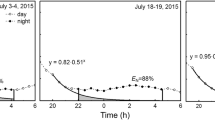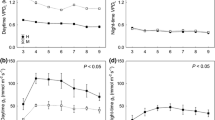Abstract
Although night-time water relations have been studied in different plant species in the last decade, there is limited information about the impact of climate variables on endogenous regulation of night-time water relations in trees. The aim of the current study was to elucidate how long-term exposure to increased air humidity impacts night-time gaseous and liquid phase conductance and gas exchange in cut shoots of hybrid aspen (Populus tremula L. × P. tremuloides Michx.) sampled from the free air humidity manipulation experimental site and measured at constant air relative humidity (RH) level in a growth chamber. Neither the early-night leaf conductance (g n1) nor canopy conductance (g c) differed (P > 0.05) between the humidification (H) and control (C) treatments. However, there was a significant (P < 0.01) difference in predawn leaf conductance (g n5) and shoot hydraulic conductance (K 5) between the treatments, with the shoots from the H treatment opening their stomata more efficiently before dawn. Both the early-night dark respiration (R 1) and height increment of stump sprouts were significantly higher (P < 0.01) in the control than in the H treatment. Although the relationship between g n5 and predawn dark respiration (R 5) was statistically significant (P < 0.01) in the H treatment, the gn5 did not depend on R 5 in the C treatment. Our findings suggest that endogenous increase in predawn water flux associates with decreased growth rate of hybrid aspen grown at elevated RH. Thus, regional changes in air humidity may potentially impact night-time water relations in fast-growing tree species like hybrid aspen.





Similar content being viewed by others
References
Aliniaeifard S, Malcolm Matamoros P, Van Meeteren U (2014) Stomatal malfunctioning under low VPD conditions: induced by alterations in stomatal morphology and leaf anatomy or in the ABA signaling? Physiol Plant 152:688–699. doi:10.1111/ppl.12216
Almeida-Rodriguez AM, Hacke UG, Laur J (2011) Influence of evaporative demand on aquaporin expression and root hydraulics of hybrid poplar. Plant Cell Environ 34:1318–1331. doi:10.1111/j.1365-3040.2011.02331.x
Arve LE, Torre S (2015) Ethylene is involved in high air humidity promoted stomatal opening of tomato (Lycopersicon esculentum) leaves. Funct Plant Biol 42:376–386. doi:10.1071/FP14247
Arve LE, Terfa MT, Gislerød HR, Olsen JE, Torre S (2013) High relative air humidity and continuous light reduce stomata functionality by affecting the ABA regulation in rose leaves. Plant Cell Environ 36:382–392. doi:10.1111/j.1365-3040.2012.02580.x
Auchincloss L, Easlon HM, Levine D, Donovan L, Richards JH (2014) Pre-dawn stomatal opening does not substantially enhance early-morning photosynthesis in Helianthus annuus. Plant Cell Environ 37:1364–1370. doi:10.1111/pce.12241
Baaziz KB, Lopez D, Rabot A, Combes D, Gousset A, Bouzid S, Cochard H, Sakr S, Venisse J-S (2012) Light-mediated Kleaf induction and contribution of both the PIP1s and PIP2s aquaporins in five tree species: walnut (Juglans regia) case study. Tree Physiol 32:423–434. doi:10.1093/treephys/tps022
Barbeta A, Ogaya R, Peñuelas J (2012) Comparative study of diurnal and nocturnal sap flow of Quercus ilex and Phillyrea latifolia in a Mediterranean holm oak forest in Prades (Catalonia, NE Spain). Trees 26:1651–1659. doi:10.1007/s00468-012-0741-4
Caird MA, Richards JH, Donovan LA (2007) Nighttime stomatal conductance and transpiration in C3 and C4 plants. Plant Physiol 143:4–10. doi:10.1104/pp.106.092940
Christman MA, Donovan LA, Richards JH (2009) Magnitude of nighttime transpiration does not affect plant growth or nutrition in well-watered Arabidopsis. Physiol Plant 136:264–273. doi:10.1111/j.1399-3054.2009.01216.x
Daley MD, Phillips NG (2006) Interspecific variation in nighttime transpiration and stomatal conductance in a mixed New England deciduous forest. Tree Physiol 26:411–419. doi:10.1093/treephys/26.4.411
Easlon HM, Richards JH (2009) Photosynthesis affects following night leaf conductance in Vicia faba. Plant Cell Environ 32:58–63. doi:10.1111/j.1365-3040.2008.01895.x
Fanourakis D, Heuvelink E, Carvalho SMP (2013) A comprehensive analysis of the physiological and anatomical components involved in higher water loss rates after leaf development at high humidity. J Plant Physiol 170:890–898. doi:10.1016/j.jplph.2013.01.013
Fordham MC, Harrison-Murray RS, Knight L, Evered CE (2001) Effects of leaf wetting and high humidity on stomatal function in leafy cuttings and intact plants of Corylus maxima. Physiol Plant 113:233–240. doi:10.1034/j.1399-3054.2001.1130211.x
Geigenberger P (2011) Regulation of starch biosynthesis in response to a fluctuating environment. Plant Physiol 155:1566–1577. doi:10.1104/pp.110.170399
Howard AR, Donovan LA (2007) Helianthus nighttime conductance and transpiration respond to soil water but not nutrient availability. Plant Physiol 143:145–155. doi:10.1104/pp.106.089383
IPCC (2013) Climate Change 2013: The Physical Science Basis. Cambridge University Press, Cambridge
Kudoyarova GR, Veselov DS, Faizov RG, Veselova SV, Ivanov EA, Farkhutdinov RG (2007) Stomata response to changes in temperature and humidity in wheat cultivars grown under contrasting climatic conditions. Russ J Plant Physiol 54:46–49. doi:10.1134/S1021443707010074
Kupper P, Sõber J, Sellin A, Lõhmus K, Tullus A, Räim O, Lubenets K, Tulva I, Uri V, Zobel M, Kull O, Sõber A (2011) An experimental facility for tree air humidity manipulation (FAHM) can alter water flux through deciduous tree canopy. Environ Exp Bot 72:432–438. doi:10.1016/j.envexpbot.2010.09.003
Kupper P, Rohula G, Saksing L, Sellin A, Lõhmus K, Ostonen I, Helmisaari H-S, Sõber A (2012) Does soil nutrient availability influence night-time water flux of aspen saplings? Environ Exp Bot 82:37–42. doi:10.1016/j.envexpbot.2012.03.013
Lasceve G, Leymarie J, Vavasseur A (1997) Alterations in light-induced stomatal opening in a stach deficient mutant of Arabidopsis thaliana L. deficient in chloroplast phosphoglucomutase activity. Plant Cell Environ 20:350–358. doi:10.1046/j.1365-3040.1997.d01-71.x
Laur J, Hacke UG (2013) Transpirational demand affects aquaporin expression in poplar roots. J Exp Bot 64:2283–2293. doi:10.1093/jxb/ert096
Lewis JD, Phillips NG, Logan BA, Hricko CR, Tissue DT (2011) Leaf photosynthesis, respiration and stomatal conductance in six Eucalyptus species native to mesic and xeric environments growing in a common garden. Tree Physiol 31:997–1006. doi:10.1093/treephys/tpr087
Li G, Santoni V, Maurel C (2013) Plant aquaporins: roles in plant physiology. Biochim Biophys Acta 1840:1574–1582. doi:10.1016/j.bbagen.2013.11.004
Lihavainen J, Keinänen M, Keski-Saari S, Kontunen-Soppela S, Sõber A, Oksanen E (2014) Metabolic responses of silver birch (Betula pendula Roth) and hybrid aspen (Populus tremula L. x P. tremuloides Michx) leaves to increased air humidity in Free Air Humidity Manipulation (FAHM) experiment. In: Claes A, Åsman A, Yazdkhasti E, El-Daim IAMA, Stephan J, Yi J, Hatorangan MR, Pucholt P, Batista R (eds) The 8th scandinavian plant physiology society Ph.D. students conference book. Uppsala, Sweden, p 63
Lopez D, Venisse JS, Fumanal B, Chaumont F, Guillot E, Daniels MJ, Cochard H, Julien JL, Gousset-Dupont A (2013) Aquaporins and leaf hydraulics: poplar sheds new light. Plant Cell Physiol 54:1963–1975. doi:10.1093/pcp/pct135
Martins MCM, Hejazi M, Fettke J, Steup M, Feil R, Krause U, Arrivault S, Vosloh D, Figueroa CM, Ivakov A, Yadav UP, Piques M, Metzner D, Stitt M, Lunn JE (2013) Feedback inhibition of starch degradation in arabidopsis leaves mediated by trehalose 6-phosphate. Plant Physiol 163:1142–1163. doi:10.1104/pp.113.226787
Niglas A, Kupper P, Tullus A, Sellin A (2014) Responses of sap flow, leaf gas exchange and growth of hybrid aspen to elevated atmospheric humidity under field conditions. AoB Plants 6:plu021. doi:10.1093/aobpla/plu021
Niglas A, Alber M, Suur K, Jasinska AK, Kupper P, Sellin A (2015) Does increased air humidity affect stomatal morphology and functioning in hybrid aspen ? Botany 93:243–250. doi:10.1139/cjb-2015-0004
Ogle K, Lucas RW, Bently LP, Cable JM, Barron-Gafford GA, Griffith A, Ignace D, Jenerette GD, Tyler A, Huxman TE, Loik ME, Smith SD, Tissue DT (2012) Differential daytime and night-time stomatal behaviour in plants from North American deserts. New Phytol 194:464–476. doi:10.1111/j.1469-8137.2012.04068.x
Oksanen E, Amores G, Kokko H, Santamaria JM, Kärenlampi L (2001) Genotypic variation in growth and physiological responses of Finnish hybrid aspen (Populus tremuloides × P. tremula) to elevated tropospheric ozone concentration. Tree Physiol 21:1171–1181. doi:10.1093/treephys/21.16.1171
Oren R, Phillips N, Ewers BE, Pataki DE, Megonigal JP (1999) Sap-flux-scaled transpiration responses to light, vapour pressure deficit, and leaf area reduction in a flooded Taxodium distichum forest. Tree Physiol 19:37–347. doi:10.1093/treephys/19.6.337
Prado K, Boursiac Y, Tournaire-Roux C, Monneuse J-M, Postaire O, Da Ines O, Schäffner AR, Hem S, Santoni V, Maurel C (2013) Regulation of Arabidopsis leaf hydraulics involves light-dependent phosphorylation of aquaporins in veins. Plant Cell 25:1029–1039. doi:10.1105/tpc.112.108456
R Core Team (2014) R: a language and environment for statistical computing. R Foundation for Statistical Computing, Vienna, Austria. http://www.R-project.org/
Resco de Dios V, Goulden ML, Ogle K, Richardson AD, Hollinger DY, Davidson EA, Alday JG, Barron-Gafford GA, Carrara A, Kowalski AS, Oechel WC, Reverter BR, Scott RL, Varner RK, Diaz-Sierra R, Moreno JM (2012) Endogenous circadian regulation of carbon dioxide exchange in terrestrial ecosystems. Glob Change Biol 18:1956–1970. doi:10.1111/j.1365-2486.2012.02664.x
Resco de Dios V, Diaz-Sierra R, Goulden ML, Barton CVM, Boer MM, Gessler A, Ferrio JP, Pfautsch S, Tissue DT (2013) Woody clockworks: circadian regulation of night-time water use in Eucalyptus globulus. New Phytol 200:743–752. doi:10.1111/nph.12382
Resco de Dios V, Loik ME, Smith R, Aspinwall MJ, Tissue DT (2016) Genetic variation in circadian regulation of nocturnal stomatal conductance enhances carbon assimilation and growth. Plant Cell Environ 39:3–11. doi:10.1111/pce.12598
Rezaei Nejad A, Van Meeteren U (2005) Stomatal response characteristics of Tradescantia virginiana grown at high relative air humidity. Physiol Plant 125:324–332. doi:10.1111/j.1399-3054.2005.00567.x
Rohula G, Kupper P, Räim O, Sellin A, Sõber A (2014) Patterns of night-time water use are interrelated with leaf nitrogen concentration in shoots of 16 deciduous woody species. Environ Exp Bot 99:180–188. doi:10.1016/j.envexpbot.2013.11.017
Rosenvald K, Tullus A, Ostonen I, Uri V, Kupper P, Aosaar J, Varik M, Sõber J, Niglas A, Hansen R, Rohula G, Kukk M, Sõber A, Lõhmus K (2014) The effect of elevated air humidity on young silver birch and hybrid aspen biomass allocation and accumulation—acclimation mechanisms and capacity. For Ecol Man 330:252–260. doi:10.1016/j.foreco.2014.07.016
Sellin A, Niglas A, Õunapuu-Pikas E, Kupper P (2014) Rapid and long-term effects of water deficit on gas exchange and hydraulic conductance of silver birch trees grown under varying atmospheric humidity. BMC Plant Biol 14:72. doi:10.1186/1471-2229-14-72
Suplice R, Pyl E-T, Ishihara H, Trenkamp S, Steinfath M, Witucka-Wall H, Gibon Y, Usadel B, Poree F, Piques MC, Korff MV, Steinhauser MC, Keurentjes JJB, Guenther M, Hoehne M, Selbig J, Fernie AR, Altmann T, Stitt M (2009) Starch as a major integraator in the regulation of plant growth. PNAS 106:10348–10353. doi:10.1073/pnas.0903478106
Takase T, Ishikawa H, Murakami H, Kikuchi J, Sato-Nara K, Suzuki H (2011) The circadian clock modulates water dynamics and aquaporin expression in Arabidopsis roots. Plant Cell Physiol 52:373–383. doi:10.1093/pcp/pcq198
Torre S, Fjeld T, Gislerød HR, Moe R (2003) Leaf anatomy and stomatal morphology of greenhouse roses grown at moderate or high air humidity. J Am Soc Hortic Sci 128:598–602
Tullus A, Kupper P, Sellin A, Parts L, Sõber A, Tullus T, Lõhmus K, Sõber J, Tullus H (2012) Climate change at northern latitudes: rising atmospheric humidity decreases transpiration, N-uptake and growth rate of hybrid aspen. PLoS One 7:e42648. doi:10.1371/journal.pone.0042648
Zak DR, Kubiske ME, Pregitzer KS, Burton AJ (2012) Atmospheric CO2 and O3 alter competition for soil nitrogen in developing forests. Glob Change Biol 18:1480–1488. doi:10.1111/j.1365-2486.2011.02596.x
Zeppel MJB, Lewis JD, Phillips NG, Tissue DT (2014) Consequences of nocturnal water loss: a synthesis of regulating factors and implications for capacitance, embolism and use in models. Tree Physiol 34:1047–1055. doi:10.1093/treephys/tpu089
Acknowledgments
This study was supported by the Estonian Ministry of Education and Research (Target financing project SF0180025s12 and Institutional research funding IUT34-9) and by the EU through the European Regional Development Fund (Centre of Excellence in Environmental Adaptation). Field studies in the FAHM experimental site were supported by the European Regional Development Fund, Project No. 3.2.0802.11-0043 (BioAtmos). We are grateful to Ilmar Part for language revision and to two anonymous reviewers for constructive remarks and helpful comments on the previous versions of the manuscript.
Author information
Authors and Affiliations
Corresponding author
Rights and permissions
About this article
Cite this article
Rohula, G., Tulva, I., Tullus, A. et al. Endogenous regulation of night-time water relations in hybrid aspen grown at ambient and elevated air humidity. Reg Environ Change 17, 2169–2178 (2017). https://doi.org/10.1007/s10113-016-1024-1
Received:
Accepted:
Published:
Issue Date:
DOI: https://doi.org/10.1007/s10113-016-1024-1




